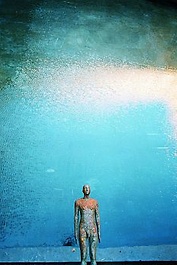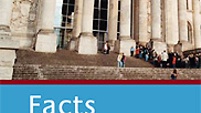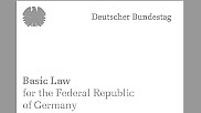Navigationspfad: Startseite > Kultur & Geschichte > Ausstellungen > Kunstausstellungen > Antony Gormley
Antony Gormley: Feeling Material
One of the German Bundestag’s most remarkable architectural art projects is a work created by the British sculptor Antony Gormley, the installation entitled Stands and Falls, dating from 2001. In the Jakob Kaiser Building, in which the Members of the Bundestag have their offices, Gormley completely flooded an inner courtyard. A footbridge is the only way across the water into the courtyard. The water reflects five sculptures, which are fixed at right angles to the walls of the courtyard and appear to be walking up them. It is only through this installation that the inner courtyard takes on a unique life of its own, for without the sculptures and their reflection the space would be defined by geometrical architectural shapes and would be downright abstract.
The sculptures, however, provide reference dimensions to add a human element. In this way, an otherwise inactive space becomes sensorily and intellectually perceptible to the beholder as a result of perplexity at the sight of figures jutting out at right angles into the space above the courtyard. The figures are casts of the artist’s body, made from cast iron. The traces of the production process are easily recognisable in seams, flashes and pouring channels. The figures have taken on a rusty patina and are thus defiantly at odds, as it were, with the smooth perfection of the architecture.
As Gormley himself said in an interview in 1994, “What I love most is when there is a sense of an architectural structure which has within it notions of opposition”. In this way, the installation reflects the artist’s aesthetic and social interest in using sculpture to enable people to rediscover a physical and spatial link to their environment, in which they often feel alienated.
The British sculptor is one of the leading artists of the present day. Gormley first rose to prominence in 1994 when he won the Tate Gallery’s Turner Prize for his series of installations entitled Field. In exhibitions around the world, along with numerous collaborators whom he engaged locally, he had produced masses of little clay figures, covering the entire exhibition area with them.
Visitors could not enter the exhibition area but were faced with hundreds or even thousands of pairs of eyes fixed on them by the sculptures, figures that resembled each other but were nevertheless individual and were the result of a collective creative process. A similar stir was caused by his 20-metre-high sculpture Angel of the North (1998), which stands near Gateshead in the north-east of England, its 54-metre wingspan, visible for miles, seeming to embrace the surrounding countryside, and by his 30-metre-high sculpture Quantum Cloud, completed one year later and erected near the Millennium Dome on the bank of the Thames.
His creations, then, have been constantly changing, but time and again they focus on the human body as the medium through which space and the world are experienced, integrating it into a coordinate system of social and aesthetic connections. The present sculptures, in their fragile beauty, shed new light on this basic idea of the artist’s. Gormley’s body can only be imagined as a hollow shape inside the sculpture, a dematerialised aura, as it were, whose radiation develops into the external space like a delicately chased etching. These sculptures are not something to be viewed from one particular angle. As people move through the area, they obtain new perspectives on a work that epitomises the paradoxical, being both a drawing and a sculpture, filling a void as well as guiding the eye towards new open spaces, fragile yet full of energy, apparently rigid and yet utterly kinetic - a metal sculpture, certainly, but expanding outward like an organic entity.
Feeling Material, the sculpture that gave its name to the exhibition, virtually dissolves the body into the energetic vibrations of concentric circles and is reminiscent of Oskar Schlemmer’s Bauhaus figures and the vibrancy of the roaring twenties. The related drawings that are on display modulate the interplay between 3-D and two-dimensionality, into which the vigour of the movements introduces time as a kind of fourth dimension and imbues the drawings and sculptures with the properties of an event.
The present exhibition in the Bundestag marking the award of the Bernhard Heiliger Prize for Sculpture 2007 to the artist by the Bernhard Heiliger Foundation and the parallel exhibition in the Georg Kolbe Museum turn the spotlight on the top British sculptor of the present day and provide an insight into the development of his work. They show that Antony Gormley not only diversifies the phenomenon of the human body in his sculptures but also uses his creations to offer an entirely new perspective on space and the body and to impart a new awareness of man’s relationship with the environment, space and time.
Kunst-Raum des Deutschen Bundestages
German Bundestag exhibition gallery
Marie-Elisabeth Lüders Building, Schiffbauerdamm, 10117 Berlin
Opening hours:
Tuesday to Sunday
from 11 a.m. to 5 p.m.
Entrance on the Spree Promenade opposite the Reichstag building
text: Andreas Kaernbach, Curator of the German Bundestag Art Collection
Telephon for further information: +49 (0)30 227 32027





